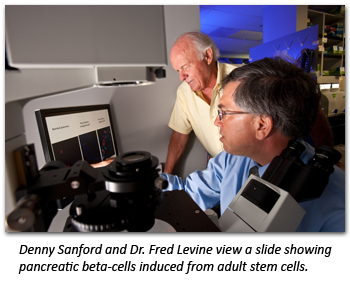
The Sanford Children’s Health Research Center was established at the Sanford-Burnham Medical Research Institute by a $20 million gift from South Dakota philanthropist Denny Sanford through Sanford Health. The gift serves as the foundation for collaboration between Sanford Health and the Sanford-Burnham Medical Research Institute. The collaboration between the Center in La Jolla and a sister Center in Sioux Falls led by Dr. David Pearce, combines world-class scientific talent with state-of-the art technology to conquer childhood diseases.
“I have the utmost confidence that this collaboration will promote solutions to some of the most troubling health issues that affect children,” said Denny Sanford when the gift was announced. “Nothing gives me greater pleasure than to encourage efforts and activities that I know will help children enjoy the gift of good health.”
“The opportunity to collaborate with Sanford Health expands our ability to combine Sanford-Burnham’s world class laboratory research with a powerful clinical partner dedicated to advancing medicine,” said John Reed, M.D., Ph.D., Sanford-Burnham’s CEO and Professor and Donald Bren Executive Chair. “Denny Sanford’s gift and his commitment to improving child health will enable us to consolidate and expand our present pediatric medical research activities and to speed our progress towards solving the unmet medical needs of children. We are honored for the opportunity to work with Mr. Sanford and the Sanford Health organization towards this noble goal.”
Many egregious diseases that predominantly affect children are largely unaddressed by the biopharmaceutical industry and underfunded by government agencies. Even diseases as prevalent as Type I (juvenile) diabetes and autism receive less attention than they deserve, based on their impact on children. The mission of the Sanford Children’s Health Research Center is to make meaningful progress towards combating the diseases of children that others have chosen to ignore.
Our goal is to be a world leader in providing solutions to the egregious childhood diseases. Our approach to achieving this goal is to combine outstanding basic research that reveals the fundamental causes of children’s diseases with innovative technologies that help to translate those discoveries into clinical benefits. Already among our early successes are:
(1) the first successful treatment for hypophosphatasia, a genetic bone disorder of children;
(2) the first successful treatments for some types of congenital disorders of glycosylation (CDG), genetic diseases in which proteins are incompletely modified by the addition of sugars;
(3) the first chemical agonists of HNF4, a “master switch” that controls generation of insulin-producing pancreatic beta cells, providing a new path forward for future treatment of juvenile diabetes;
(4) discovery that adult pancreas contains residual stem cells capable of being converted into insulin-producing beta cells;
(5) identification of chemicals that convert stem cells into heart cells and advanced pre-clinical applications of those cells for addressing heart disease; and
(6) discovery of non-coding RNAs involved in AIDS pathogenesis, revealing new ways to devise therapeutic strategies for combating HIV – an infectious disease that directly affects hundreds of thousands of children worldwide.
 Research within the Sanford Children’s Health Research Center is based on three pillars. First, we emphasize developmental biology, the study of how complex organisms are assembled starting from a single cell (the fertilized egg). Our core strengths in stem cells and developmental biology help us to understand what goes wrong in children with inherited diseases and provides us with insights how to regenerate, replace, and restore defective organs and tissues. Second, we employ a multi-disciplinary strategy to assemble complementary talents and focus them on solving problems in childhood health. Our team goes beyond the routine of mainstream life science research to include expertise in (a) RNA biology, seeking to understand how the world of non-coding RNAs (representing 98% of the active genome) guide cellular processes in health and disease, (b) uses of powerful, genetically tractable model organisms for developing new strategies in regenerative biology, and (c) chemical biology approaches to identifying chemicals that modulate drug targets and cellular pathways in therapeutically useful ways, thus setting the stage for production of innovative new therapeutics. Third, we embrace technology as a means to empower science and as an aide to making progress where others have failed. The Sanford Children’s Health Research Center’s team is bolstered by the access to the Institute’s extremely powerful core facilities that give flight to bold new ideas and extend imagination into tangible reality.
Research within the Sanford Children’s Health Research Center is based on three pillars. First, we emphasize developmental biology, the study of how complex organisms are assembled starting from a single cell (the fertilized egg). Our core strengths in stem cells and developmental biology help us to understand what goes wrong in children with inherited diseases and provides us with insights how to regenerate, replace, and restore defective organs and tissues. Second, we employ a multi-disciplinary strategy to assemble complementary talents and focus them on solving problems in childhood health. Our team goes beyond the routine of mainstream life science research to include expertise in (a) RNA biology, seeking to understand how the world of non-coding RNAs (representing 98% of the active genome) guide cellular processes in health and disease, (b) uses of powerful, genetically tractable model organisms for developing new strategies in regenerative biology, and (c) chemical biology approaches to identifying chemicals that modulate drug targets and cellular pathways in therapeutically useful ways, thus setting the stage for production of innovative new therapeutics. Third, we embrace technology as a means to empower science and as an aide to making progress where others have failed. The Sanford Children’s Health Research Center’s team is bolstered by the access to the Institute’s extremely powerful core facilities that give flight to bold new ideas and extend imagination into tangible reality.
Working together, and with our collaborative partners, our mission is to provide breakthroughs in medical research that lead to cures for life threatening diseases of children.